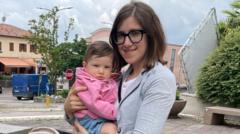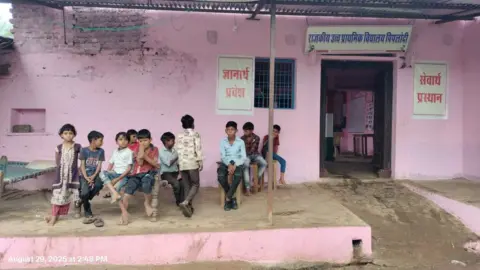In the picturesque town of Fregona, Italy, Mayor Giacomo de Luca confronts a stark reality: the town, nestled at the foot of the mountains, is seeing a rapid population decline. Closed businesses line the streets—supermarkets, barbershops, and restaurants have all shuttered, echoing a broader national crisis of declining births. Local schools are feeling the impact, with Fregona's primary school at risk of closure due to insufficient enrollment. "We only have four children for the new Year One, far below the required ten for funding," explains de Luca, whose concern about the school's future is palpable.
The population of Fregona has decreased by nearly 20% in just the past decade, with statistics revealing only four new births in the town by mid-year. Among the 2,700 remaining residents, many are elderly, raising alarms about the community’s sustainability. De Luca has been proactive, visiting local industries to persuade families to move their children to Fregona, offering transportation and extended school hours paid by the local council, underscoring the urgency of the situation.
Italy's demographic challenge is not limited to Fregona; it is a national issue with the population contracting by approximately 1.9 million over the last decade and birth rates plummeting for 16 consecutive years. Currently, Italian women are averaging a record low of just 1.18 children each, significantly below the EU average of 1.38 and the 2.1 birth rate required merely to maintain the population.
Despite governmental initiatives aimed at encouraging higher birth rates, such as financial incentives and tax breaks, many young Italians express hesitance in starting families. Local mother Valentina Dottor reflects on the challenging environment, where even a modest monetary allowance for newborns struggles to alleviate the high costs of childcare and education, forcing many to delay childbirth or reconsider family planning entirely.
In response to the declining birth rates, some businesses in the Veneto region, particularly family-run firms like Irinox, have taken innovative steps to address the issue. They established a subsidized creche near their industrial sites to ease parental burdens and retain valuable employees. Such proactive measures are seen as essential by both employers and parents navigating childcare challenges amidst the backdrop of dwindling birth rates.
Migration is also part of the conversation as Italy looks to bolster its workforce; over 40% of Irinox employees are foreign workers. However, increased immigration often stirs up contentious political debates in the current climate. The example of Pascoli Primary School in nearby Treviso highlights the consequences of declining student enrollments, leading to permanent closures due to demographic shifts compounded by immigration and local families' choices.
As Italy faces UN predictions of a population decline of five million in the next 25 years, debates on how to revitalize parent support systems continue. Parents in Treviso, like Eleanora Franceschi, seek more than just financial assistance—calling for practical services to support families, emphasizing that merely increasing financial handouts is insufficient for creating a family-friendly environment. “How can we have more babies in this situation?” she questions, highlighting the urgency for meaningful change in Italy’s social infrastructure.
The population of Fregona has decreased by nearly 20% in just the past decade, with statistics revealing only four new births in the town by mid-year. Among the 2,700 remaining residents, many are elderly, raising alarms about the community’s sustainability. De Luca has been proactive, visiting local industries to persuade families to move their children to Fregona, offering transportation and extended school hours paid by the local council, underscoring the urgency of the situation.
Italy's demographic challenge is not limited to Fregona; it is a national issue with the population contracting by approximately 1.9 million over the last decade and birth rates plummeting for 16 consecutive years. Currently, Italian women are averaging a record low of just 1.18 children each, significantly below the EU average of 1.38 and the 2.1 birth rate required merely to maintain the population.
Despite governmental initiatives aimed at encouraging higher birth rates, such as financial incentives and tax breaks, many young Italians express hesitance in starting families. Local mother Valentina Dottor reflects on the challenging environment, where even a modest monetary allowance for newborns struggles to alleviate the high costs of childcare and education, forcing many to delay childbirth or reconsider family planning entirely.
In response to the declining birth rates, some businesses in the Veneto region, particularly family-run firms like Irinox, have taken innovative steps to address the issue. They established a subsidized creche near their industrial sites to ease parental burdens and retain valuable employees. Such proactive measures are seen as essential by both employers and parents navigating childcare challenges amidst the backdrop of dwindling birth rates.
Migration is also part of the conversation as Italy looks to bolster its workforce; over 40% of Irinox employees are foreign workers. However, increased immigration often stirs up contentious political debates in the current climate. The example of Pascoli Primary School in nearby Treviso highlights the consequences of declining student enrollments, leading to permanent closures due to demographic shifts compounded by immigration and local families' choices.
As Italy faces UN predictions of a population decline of five million in the next 25 years, debates on how to revitalize parent support systems continue. Parents in Treviso, like Eleanora Franceschi, seek more than just financial assistance—calling for practical services to support families, emphasizing that merely increasing financial handouts is insufficient for creating a family-friendly environment. “How can we have more babies in this situation?” she questions, highlighting the urgency for meaningful change in Italy’s social infrastructure.





















